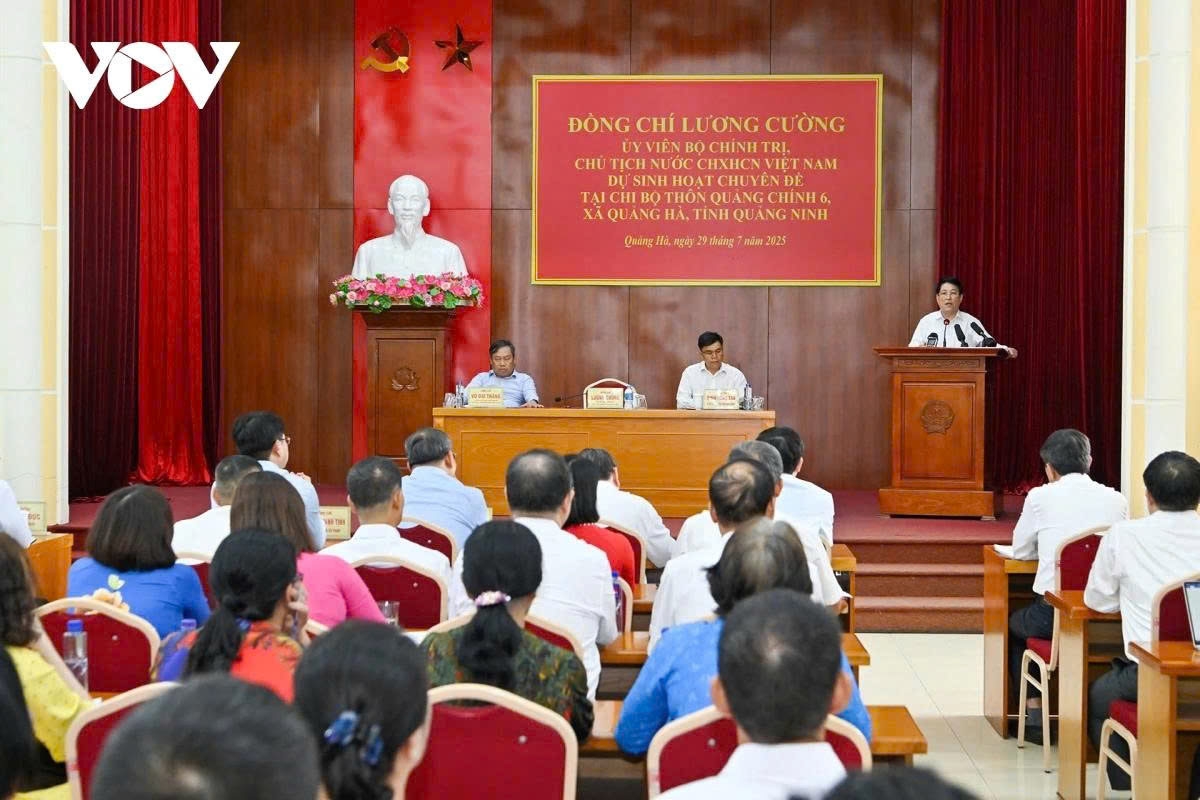
VOV.VN - President Luong Cuong on July 29 attended a special session of the Party cell of Quang Chinh 6 village in Quang ha commune, Quang Ninh province, to review the implementation of the newly established two-tier local government model following recent administrative mergers.

During the meeting, Party members discussed the early outcomes of the new governance model and shared insights on how to improve its effectiveness in serving the public. Several suggestions were made to strengthen operational efficiency and better meet local needs.
Quang Ha commune was officially established on July 1, 2025, following the merger of four former commune-level administrative units and part of Quang Long commune. With an area of 134.37 km² and nearly 41,000 residents living across 53 villages and residential quarters, it is one of the largest communes in the province.
Strategically located in the Mong Cai Border Gate Economic Zone, Quang Ha also includes a 5,000-hectare coastal industrial zone, creating major opportunities for multi-sector economic growth, investment attraction, and enhanced logistics connectivity throughout the Northeastern region.
Following its establishment, the commune quickly finalised its organisational structure, assigned key personnel, built necessary infrastructure, and ensured smooth government operations from day one. These initial successes reflect the strong and proactive leadership of the local Party Committee in turning national and provincial policies into concrete local actions.
Speaking at the session, President Luong Cuong commended the early achievements in implementing the two-tier government model in Quang Ninh.
"Quang Ninh must continue to strengthen its leadership efforts, especially at the grassroots level, by improving the capacity and fighting spirit of local Party organisations,” said President Luong Cuong.
“Party cells play a central role in understanding public concerns and turning high-level policies into real, measurable outcomes,” he stressed.
He also acknowledged the challenges posed by administrative restructuring, urging local authorities to keep refining the government structure, enhance the quality of personnel, and maintain a streamlined, effective, and people-focused administration. In addition, he emphasised the importance of social welfare, education, healthcare, environmental protection, and national defense in the newly merged areas.
Looking ahead to the upcoming Party congresses, the President called for an honest evaluation of post-merger conditions. He stressed the need for clear, practical goals and highlighted the importance of democratic, fair personnel selection to ensure that individuals with integrity, capability, and the courage to take responsibility are chosen to lead local development in the next phase.
Vietnam’s rollout of two-tier local administration model and restructuring of provincial administrative units is a sound policy that conforms to global trends. Dr. Luong Tuan Anh from the UK’s De Montfort University told the Vietnam News Agency (VNA)'s resident reporters in London.
VOV.VN - Prime Minister Pham Minh Chinh on July 13 chaired a conference to review the implementation of the two-tier local government model in Can Tho city and other localities in the Mekong Delta region.
VOV.VN - Digital transformation is a vital link between provinces and communes in the new two-tier local government model. It must serve as a data brain to aggregate and analyze information, enabling early warnings and ensuring full and timely access to information, says Party General Secretary To Lam.
Bình luận
Bình luận của bạn sẽ được xét duyệt trước khi đăng